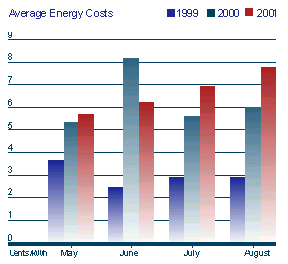Electricity Outlook 2002: A Call To Action
Introduction
Despite an economic downturn and the destruction of the World Trade Center complex, there remains an urgent need for 2,000-3,000 megawatts (MW) of new electric capacity in New York City over the next five years. This additional power is needed to meet projected growth in demand through 2006, to replace aging plants with cleaner, more efficient ones, and to provide a cushion of supply that will prevent dramatic increases in consumer costs for electricity. Furthermore, while the need before and after the tragic events of September 11 remains largely unchanged, conditions for the financing, construction and completion of new generating facilities have worsened due to the financial uncertainties created by the collapse of the Enron Corporation. Electricity Outlook: A Call To Action follows the January 2001 edition of Electricity Outlook: A Matter of Urgency, and provides current evaluations of the City’s electricity demand forecasts and prospects for new sources of supply. This report also reviews additions to the City’s electric supply for the summer of 2001 and the subsequent surge in demand during the heat wave in August, which left the City with only a narrow margin of supply to prevent service disruptions. Even if peak load demand in 2002 just matches last year’s historic high levels, the summer of 2002 will require aggressive conservation measures to help reduce demand, especially during peak demand periods.
As New York City rebuilds, and recovers from a lingering recession, electricity demand will continue to grow. Additional energy efficiency and clean distributed technologies could yield 500 MW in the next five years, but will not supply enough reliable power to meet the City’s needs. New generating facilities must be proposed, constructed and built ‘in-city’ within the five boroughs. This is especially challenging since some generating plant proposals are currently being reconsidered, postponed or withdrawn.
The perception at present appears to be that both the California and New York City crises of 2001, over insufficient electric supply and rising prices, have subsided. Yet, the situation facing New York City in early 2002 has not improved, and the urgent need for additional electric capacity still exists.
 Consequently,
this report is a call to action to alert political and business
leaders in both the City and State to the continuing need
for energy efficiency, clean distributed generation, and new
generating capacity, and the need to expedite the approval
of proposed generating facilities through New York State’s
Article X process.
Consequently,
this report is a call to action to alert political and business
leaders in both the City and State to the continuing need
for energy efficiency, clean distributed generation, and new
generating capacity, and the need to expedite the approval
of proposed generating facilities through New York State’s
Article X process.
Factors Affecting Electricity Demand and
Supply in NYC During 2001
Spurred by concern over the reliability and cost of electricity
in New York City, as well as by the lessons learned from the
power crisis in California, several important actions were
taken by both the public and privatesectors to ensure sufficient
electric supply in New York City during 2001.
- 709 MW of new generating capacity was added for the summer
of 2001, which helped to meet unprecedented demands from
New York City
residents and businesses. The new supply included: ten natural gas
turbines installed by the New York Power Authority at various locations throughout the City; restoration of various generators by Con Edison and Orion Power; and, a station upgrade at the Linden Cogeneration Plant. - Voluntary conservation efforts and energy efficiency measures helped maintain the reliability of the electrical system during the August heat wave when consumption soared to the record-breaking level of 10,650 MW.
Summer 2001 Experience
Given the traumatic events of September 11 and America’s
subsequent
war on terror both home and abroad, it is easy to lose sight
of the electricity
crisis that New York City faced just one month prior to the
attack. For five consecutive business days during the week
of August 6, 2001, New York experienced temperatures in the
90’s F., with high humidity. The resulting surge in electricity
demand exceeded the peak load forecast by 115 MW and created
the widespread and well-founded concern that the City would
not have enough electricity to avoid power outages.
In response, the New York State Independent System Operator
(NYISO) declared a series of power emergencies. Residents
and businesses were strongly urged to conserve wherever possible,
and, through a joint initiative of the New York City Partnership
and the Real Estate Board of New York, many of the City’s
building owners shut down 25-30 percent of their elevators
and escalators and trimmed perimeter and lobby lighting. All
of these
measures reduced electricity demand by 160 MW when the power
system was under the most strain.
Price Changes in 2001:
Wholesale power prices in the NYISO market were similar but
somewhat less volatile during the summer of 2001 than during
the highly volatile situation of the previous summer, but
prices in 2001 continued to be higher than in 1999 (see Chart).
Additional supplies of power, if available, would put downward
pressure on market prices in both the spot and forward markets.



